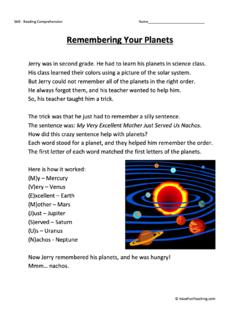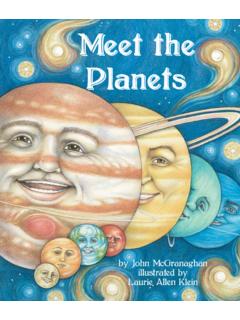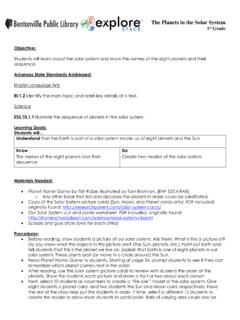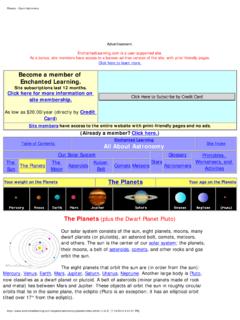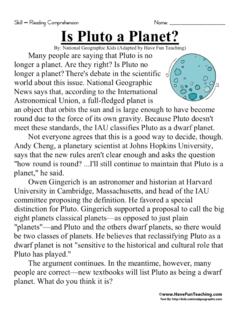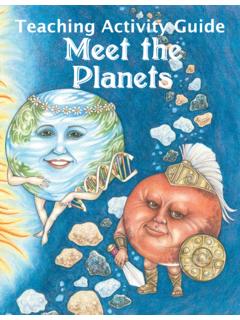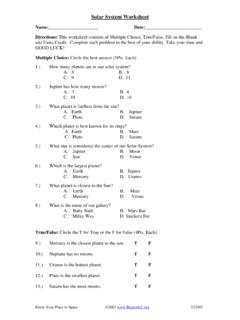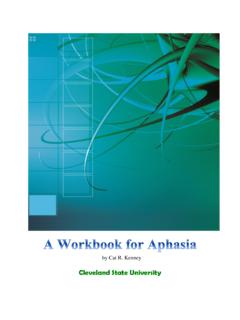Transcription of Wondering About Saturn: A Short History
1 reading ,Writing & Rings! Cassini Program website EG-2004-01-013-JPL1 Grades 3-4 Lesson 3 Wondering About saturn : A Short History LESSON Language Arts Focus Nonfiction Writing Practice: Summary Nonfiction comprehension Skills: Visualizing and Wondering Science Focus reading to Support Inquiry-Based Thinking OVERVIEW Humans have been Wondering About saturn for centuries upon centuries. In this lesson, students hear a read-aloud of the History of discoveries that have been made About saturn . Next, they learn two reading comprehen sion strategies (visualizing and Wondering ) to become more powerful readers of nonfiction text. Finally, students share their work with partners and the class. saturn , the sixth planet from the Sun, is the farthest planet that is visible without a telescope, and so it has a long History of discoveries associated with it.
2 The National Science Education Standards state that students should understand that science is an ongoing, changing enterprise. It is exciting for students to learn that scientists such as Galileo Galilei were willing to take risks and be mistaken in their quest to make sense of what they observed. The National Science Education Standards state that chil dren should understand the relationship of science and technology. The reading passage in this lesson describes the discoveries that unfold as tele scopes become larger and more powerful. WHY THIS WORKS Studies have shown that there is a decline in progress in reading in fourth grade (Chall, 1983; Chall, Jacobs, & Baldwin, 1990). This has sometimes been called the fourth-grade slump. This decline has been attributed to the fact that fourth-grade students are required to process more nonfic tion than in previous years, and have been inadequately prepared to do so.
3 This lesson gives children two concrete strategies (visualization and Wondering ) described in Mosaic of Thought (Zimmerman and Keene, 1997) to help them comprehend nonfiction text more effectively. saturn s polar auroras glow in this ultravio let view. LESSON TIME 1 hour MATERIALS CHECKLIST For the teacher: Copy of reading passage, including marked sample: Wondering About saturn : A Short History For the students: reading passage: Wondering About saturn : A Short History (one copy for each student) Pencils saturn Discovery Log Objectives Teachers will: Gain insight into how students think as they read. Students will: 1. Learn and practice reading comprehension strategies (visualizing and Wondering ) to help them make sense of nonfiction text.
4 2. Learn About the History of discoveries About saturn . reading ,Writing & Rings! Cassini Program website EG-2004-01-013-JPL2 Grades 3-4 Lesson 3 Teacher Preparation For each student plus one copy for yourself to read aloud, print out student handout 1, Wondering About saturn : A Short History (4 pages). Print a copy of teacher reference 1, Wondering About saturn : A Short His twith the introductory note from the author (to read aloud) and the sample marked page (for modeling). ory What to Do Model comprehension Strategies Suggested time 10 minutes 1. Tell the class that you are going to read a summary of the History of discover ies About saturn . Read aloud to the class Wondering About saturn : A Short History , starting with the introductory paragraph.
5 2. After you read it aloud once, give each student a copy of the reading passage. Ask the students to write the words I picture in the upper left-hand corner of the page. Ask them to write I wonder in the upper right-hand corner of the page. Explain that, next to each section, the students will draw what they picture on the left-hand side and write what they wonder on the right-hand side. 3. Model the first section for the class. (Skip the introductory note from the au thor.) Read the paragraph out loud, and then draw on the board what you picture and write what you wonder. Hold up (or show a transparency of) the sample marked reading passage Wondering About saturn : A Short History as an example of what it will look like on the page. 4.
6 Explain that the students may picture and wonder something different than what you pictured and wondered so they should mark the first section as well (have them skip the note from the author). 5. Explain to the students that they will be sharing what they picture and won der with a partner at the end of class. Read to Learn Suggested time 20 minutes Give the class time to complete all the sections. Be available if students need help with the passage. Share with a Partner Suggested time 10 minutes Have the students share what they drew and wrote with a partner. Share with the Class Suggested time 10 minutes 1. Ask if any students would like to share what they wondered or pictured with the whole class. 2. Ask students to put their name and date on their work, and put it inside their saturn Discovery Log.
7 reading ,Writing & Rings! Cassini Program website EG-2004-01-013-JPL3 Grades 3-4 Lesson 3 Extensions What Our Class Pictured and Wondered Put the reading passage on a chart. Have students cut out their pictures and what they wondered and paste them next to the reading passage. Look at the pictures and notes from the whole class. Ask children to write what they notice, and why they think it is like that. Independent Internet Research Project 1. Have students research how saturn , Titan, Pioneer, and Voyager got their names, and share this research with the class. 2. Have students research how telescopes are built and how they work, and share this research with class. Galileo s Telescope You may want to have this link to an illustration of one of Galileo s telescopes bookmarked on the computer for the children to explore Assessment As you read over the children s work, ask yourself the following questions: 1.
8 How would I rate this student s comprehension based on the pictures and questions that I see? Often reading comprehension is assessed by multiple-choice or Short -answer questions. Some students have excellent comprehension skills, but struggle with multiple-choice and Short -answer formats. This exercise provides another method to gain a sense of how well your students are making sense of what they read. 2. What vocabulary was confusing to the children? Note vocabulary that you would like to address in future lessons. Jot these ideas down next to the lesson in the unit in which they would be most appro priately integrated. 3. What misunderstandings might the students have? Note ideas that they have About science content that you would like to address in future lessons.
9 Jot these ideas down next to the lesson in the unit in which they would be most appropriately integrated. reading ,Writing & Rings! Cassini Program website EG-2004-01-013-JPL4 Grades 3-4 Lesson 3 Standards National Council of Teachers of English and International reading Association Standards for the English Language Arts All students must have opportunities to: Read a wide range of print and nonprint texts. Apply a wide range of strategies to comprehend, interpret, evaluate, and appre ciate texts. Participate as knowledgeable, reflective, creative, and critical members of a va riety of literacy communities. Use spoken, written, and visual language to accomplish their own purposes ( , for learning, enjoyment, persuasion, and the exchange of information).
10 National Science Education Standards As a result of their activities in grades K 4, all students should develop under standing: About scientific inquiry (Science as Inquiry). Of position and motion of objects (Physical Science). Of objects in the sky (Earth and Space Science). About science and technology (Science and Technology). Of science as a human endeavor ( History and Nature of Science). reading ,Writing & Rings! Cassini Program website EG-2004-01-013-JPL5 Grades 3-4 Lesson 3 TEACHER REFERENCE 1 Sample I PictureI PictureI PictureI PictureI PictureWondering About saturn : A Short History Wondering About saturn : A Short HistoryWondering About saturn : A Short HistoryWondering About saturn : A Short HistoryWondering About saturn : A Short History (A Note from the Author Behind the Scenes of Writing a Summary: Later in the unit, you will be writing summaries.)










